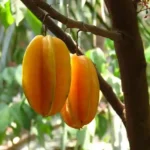Santol Fruit – The Sweet-Tart Jewel of Southeast Asia

Tucked away in the bustling markets and backyard orchards of Southeast Asia lies an underrated tropical treasure: the Santol fruit. Known scientifically as Sandoricum koetjape, Santol may not have the international fame of mangoes or pineapples, but for those who’ve tasted its complex flavor, it’s unforgettable.
What Is Santol Fruit?
Santol, often called the cotton fruit, gets its nickname from the soft, cottony pulp that surrounds its seeds. Native to Indochina and widely cultivated in the Philippines, Thailand, Malaysia, and Indonesia, Santol is a round, yellow to golden-brown fruit about the size of an apple, encased in a slightly fuzzy, leathery skin.
Inside, the real magic happens: a juicy, fibrous white pulp clings to several large seeds. Its taste is a unique blend of sweet, sour, and tangy, varying depending on the variety. There are generally two types: the yellow Santol, which is sourer, and the red Santol, known for its sweeter flesh.
A Cultural Staple
In the Philippines, Santol is more than just a fruit—it’s a part of life. Kids often climb trees to pick them fresh, and families gather around to enjoy them with a sprinkle of salt or a dip in bagoong (fermented shrimp paste). It’s also commonly used in traditional dishes like sinigang or Sinantolan—a creamy, spicy coconut-based side dish made from grated Santol rind.
In Thailand, it’s a popular ingredient in spicy salads, balancing the heat with its tartness. Whether eaten raw, cooked, or made into jams and preserves, Santol offers culinary versatility.

Open santol with seeds and pulp from Thailand – Creative Commons | Author: Steve – Source: https://commons.wikimedia.org/wiki/File:Gratorn_%E0%B8%81%E0%B8%A3%E0%B8%B0%E0%B8%97%E0%B9%89%E0%B8%AD%E0%B8%99_fruit,_Santol.jpg
Nutritional Benefits
Santol isn’t just delicious; it’s also packed with health benefits. It’s rich in:
- Dietary fiber – for digestive health
- Vitamin C – for immune support and skin health
- Antioxidants – to help fight oxidative stress
- Anti-inflammatory properties – used in traditional medicine to treat diarrhea and stomach pains
How to Eat It
To eat Santol, cut it in half and gently pry open the rind. You can suck the pulp around the seeds, but don’t bite down—swallowing the seeds can be dangerous. The rind can also be grated and cooked, especially in savory Filipino dishes.
For a twist, try:
- Santol smoothie – blended with ice, honey, and a splash of lime
- Pickled Santol – as a sour side dish
- Santol candy – boiled with sugar to make chewy tropical treats
Santol Fruit: A Worth Discovering
Santol may not yet be a global superstar, but it holds a firm place in the hearts (and tastebuds) of many in Southeast Asia. With its tart-sweet flavor and impressive health benefits, it’s a fruit worth discovering, whether you’re wandering through a tropical market or experimenting in your kitchen.
So the next time you spot this fuzzy, golden orb—give it a try. It just might be your next favorite fruit.
Learn more about trees in The Philippines.
References:
https://en.wikipedia.org/wiki/Sandoricum_koetjape










